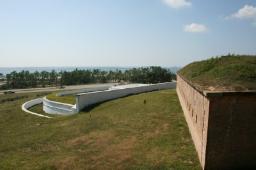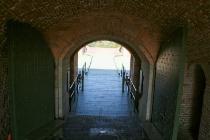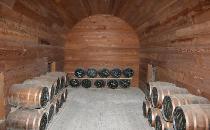Cannon at Fort Barrancas
A 19th century Columbiad aims out
at Pensacola Bay from Fort
Barrancas.
A 19th century Columbiad aims out
at Pensacola Bay from Fort
Barrancas.
Defender of Pensacola Bay
The fort functioned with Forts
Pickens and McRee across the bay
to create a brutal crossfire against
any enemy warship.
The fort functioned with Forts
Pickens and McRee across the bay
to create a brutal crossfire against
any enemy warship.
FORT BARRANCAS
Pensacola, Florida
Pensacola, Florida
Fort Barrancas in Pensacola, Florida
Fort Barrancas in Pensacola, Florida
| Fort Barrancas and the Water Battery The brick structure at right was begun by the U.S. in 1839, while the white battery is of Spanish origin. |
Defender of Pensacola Bay
Fort Barrancas overlooks the entrance to
Florida's Pensacola Bay. Part of Gulf Islands
National Seashore, the old fort is a unique
relic of America's past.
This site has served military purposes at
least since the Spanish built a fort nearby in
1698. Named for the barrancas or red clay
bluffs of Pensacola Bay, there have been a
series of forts on the site.
The French occupied the bluffs briefly in
1719, but soon returned possession to the
Spanish. After taking possession of Florida
following the French and Indian War, the
British built a fort here. The Royal Navy
Redoubt engaged Spanish ships during the
early stages of the Battle of Pensacola, a key
encounter of the American Revolution. The
British lost the 1781 battle and Florida once
again became a Spanish colony.
Spain constructed Fort San Carlos de
Barrancas at the site and during the 1790s
added a masonry water battery, the Bateria
de San Antonio, which still stands today. The
forts were seized by U.S. troops under
General Andrew Jackson in both 1814 and
1818.
The 1814 capture was an action of the War of
1812. British Royal Marines occupied the City
of Pensacola and used it as a base for an
attack on Fort Bowyer at Mobile Bay. It was a
violation of Spain's neutrality.
Maj. Gen. Andrew Jackson led an army into
Florida and marched on Pensacola. The
British withdrew from the city but Spanish
troops battled American troops in the streets
before being forced to surrender.
The British, however, blew up the wood and
earth fort of San Carlos de Barrancas after
forcing its Spanish garrison to embark on
their ships. Jackson captured the smoking
ruins along with the largely undamaged
Bateria de San Antonio. He did not try to
permanently occupy Pensacola and soon
departed,leaving Spain to rebuild its fort.
The 1818 capture was part of the First
Seminole War. Informed that Red Stick Creek
and Seminole warriors were receiving
supplies from the Spanish in Pensacola,
Jackson once again marched on the city.
The U.S. Army took Pensacola but soon
found that the Spanish troops had withdrawn
into the rebuilt fort at the Barrancas. Jackson
laid siege to the fort, his men exchanging
cannon fire with Spanish gunners in a short
but spirited battle. The American artillery was
firing from higher ground, however, and the
fort of San Carlos de Barrancas once again
passed into Jackson's hands.
His forces stayed longer this time but the fort
was soon returned to Spain. It remained
under the control of the King's forces for a
couple more years until Florida became a
U.S. territory in 1821.
To better protect the nearby U.S. Navy Yard,
the Bateria de San Antonio was improved for
use as a water battery and a new work, Fort
Barrancas, was constructed in 1839-1844. A
large military installation, Barrancas Post,
grew adjacent to the fort. The post provided
barracks, offices, hospitals and other
necessary support structures for the fort.
The new fort functioned with Fort Pickens and
Fort McRee across the bay to create a
crossfire of artillery through which any
attacking fleet would have to sail in order to
reach Pensacola.
As Andrew Jackson had easily demonstrated
in 1818, the position of Fort Barrancas was
susceptible to land attack. To counter this
deficiency, a second brick fortification called
the Advanced Redoubt was built a few
hundred yards inland to help in the fort's
defense.
By the eve of the Civil War, the small force of
U.S. troops assigned to Pensacola Bay were
quartered at Barrancas Post. Forts Pickens
and McRee were occupied by caretakers.
It is a little known fact that the first shots of
the Civil War were actually fired on the
drawbridge of Fort Barrancas on January 8,
1861, more than three months before the
Confederate bombardment of Fort Sumter.
Florida's Pensacola Bay. Part of Gulf Islands
National Seashore, the old fort is a unique
relic of America's past.
This site has served military purposes at
least since the Spanish built a fort nearby in
1698. Named for the barrancas or red clay
bluffs of Pensacola Bay, there have been a
series of forts on the site.
The French occupied the bluffs briefly in
1719, but soon returned possession to the
Spanish. After taking possession of Florida
following the French and Indian War, the
British built a fort here. The Royal Navy
Redoubt engaged Spanish ships during the
early stages of the Battle of Pensacola, a key
encounter of the American Revolution. The
British lost the 1781 battle and Florida once
again became a Spanish colony.
Spain constructed Fort San Carlos de
Barrancas at the site and during the 1790s
added a masonry water battery, the Bateria
de San Antonio, which still stands today. The
forts were seized by U.S. troops under
General Andrew Jackson in both 1814 and
1818.
The 1814 capture was an action of the War of
1812. British Royal Marines occupied the City
of Pensacola and used it as a base for an
attack on Fort Bowyer at Mobile Bay. It was a
violation of Spain's neutrality.
Maj. Gen. Andrew Jackson led an army into
Florida and marched on Pensacola. The
British withdrew from the city but Spanish
troops battled American troops in the streets
before being forced to surrender.
The British, however, blew up the wood and
earth fort of San Carlos de Barrancas after
forcing its Spanish garrison to embark on
their ships. Jackson captured the smoking
ruins along with the largely undamaged
Bateria de San Antonio. He did not try to
permanently occupy Pensacola and soon
departed,leaving Spain to rebuild its fort.
The 1818 capture was part of the First
Seminole War. Informed that Red Stick Creek
and Seminole warriors were receiving
supplies from the Spanish in Pensacola,
Jackson once again marched on the city.
The U.S. Army took Pensacola but soon
found that the Spanish troops had withdrawn
into the rebuilt fort at the Barrancas. Jackson
laid siege to the fort, his men exchanging
cannon fire with Spanish gunners in a short
but spirited battle. The American artillery was
firing from higher ground, however, and the
fort of San Carlos de Barrancas once again
passed into Jackson's hands.
His forces stayed longer this time but the fort
was soon returned to Spain. It remained
under the control of the King's forces for a
couple more years until Florida became a
U.S. territory in 1821.
To better protect the nearby U.S. Navy Yard,
the Bateria de San Antonio was improved for
use as a water battery and a new work, Fort
Barrancas, was constructed in 1839-1844. A
large military installation, Barrancas Post,
grew adjacent to the fort. The post provided
barracks, offices, hospitals and other
necessary support structures for the fort.
The new fort functioned with Fort Pickens and
Fort McRee across the bay to create a
crossfire of artillery through which any
attacking fleet would have to sail in order to
reach Pensacola.
As Andrew Jackson had easily demonstrated
in 1818, the position of Fort Barrancas was
susceptible to land attack. To counter this
deficiency, a second brick fortification called
the Advanced Redoubt was built a few
hundred yards inland to help in the fort's
defense.
By the eve of the Civil War, the small force of
U.S. troops assigned to Pensacola Bay were
quartered at Barrancas Post. Forts Pickens
and McRee were occupied by caretakers.
It is a little known fact that the first shots of
the Civil War were actually fired on the
drawbridge of Fort Barrancas on January 8,
1861, more than three months before the
Confederate bombardment of Fort Sumter.
Concerned over the secession movement in
the Southern states and aware of rumors that
state troops were preparing to move on the
post, Lieutenant Adam J. Slemmer, the
commander of Fort Barrancas, posted a
sergeant's guard in the fort and placed his
men on high alert. The guards observed
shadowy figures on the drawbridge and
confronted them. When the intruders failed to
identify themselves, the U.S. soldiers fired a
volley at them.
The Southerners, who turned out to be from
an Alabama militia company, withdrew
quickly without returning fire. They later said
they had heard the fort had been evacuated
and were approaching in the darkness to
investigate. No one was injured.
Slemmer evacuated Fort Barrancas two days
later on January 10, 1861, moving his men
over to Fort Pickens where he believed he
could wage a stronger defense. The post
was quickly occupied by Southern troops and
a standoff began with the Federals.
On November 22, 1861, and again the
following January, Confederate gunners in
the fort exchanged fire with Union troops
across the bay at Fort Pickens. The fort was
not seriously damaged in the artillery duels.
With the port of Pensacola effectively bottled
up by Union troops in Fort Pickens and the
Union Navy offshore, the Confederates
decided to evacuate the city and send the
soldiers posted there elsewhere. Fort
Barrancas was evacuated in May of 1862 and
once again fell into Union hands.
It remained in Federal hands for the rest of
the war and was the base for several
important Civil War expeditions. Among
these was the 1864 raid on Marianna, Florida.
Fort Barrancas remained an important army
post for many years after the Civil War, but is
now part of Gulf Islands National Seashore,
a national park area that stretches from
Florida to Mississippi. The fort and Bateria de
San Antonio or Water Battery have been
beautifully restored and can be visited daily.
The area includes the forts, the nearby
Advanced Redoubt, trails, picnic areas and a
very nice visitor center. Fort Barrancas is
open Thursday - Monday (Closed Tuesday
and Wednesday) from 8:30 a.m. - 4:15 p.m.
Click here for information about guided tours.
Fort Barrancas is located on board the
Pensacola Naval Air Station. Take Exit 7A
from I-10 and turn south on Pine Forest Rd.
Follow Pine Forest to Blue Angel Parkway
and turn right. Enter the Naval Air Station (ID
required) and then turn left on Taylor Road.
The entrance is on Taylor Road 1/2 mile east
of the Museum of Naval Aviation.
The address is 3182 Taylor Rd, Pensacola,
FL 32508.
Please click here to visit the official National
Park Service website for more information.
the Southern states and aware of rumors that
state troops were preparing to move on the
post, Lieutenant Adam J. Slemmer, the
commander of Fort Barrancas, posted a
sergeant's guard in the fort and placed his
men on high alert. The guards observed
shadowy figures on the drawbridge and
confronted them. When the intruders failed to
identify themselves, the U.S. soldiers fired a
volley at them.
The Southerners, who turned out to be from
an Alabama militia company, withdrew
quickly without returning fire. They later said
they had heard the fort had been evacuated
and were approaching in the darkness to
investigate. No one was injured.
Slemmer evacuated Fort Barrancas two days
later on January 10, 1861, moving his men
over to Fort Pickens where he believed he
could wage a stronger defense. The post
was quickly occupied by Southern troops and
a standoff began with the Federals.
On November 22, 1861, and again the
following January, Confederate gunners in
the fort exchanged fire with Union troops
across the bay at Fort Pickens. The fort was
not seriously damaged in the artillery duels.
With the port of Pensacola effectively bottled
up by Union troops in Fort Pickens and the
Union Navy offshore, the Confederates
decided to evacuate the city and send the
soldiers posted there elsewhere. Fort
Barrancas was evacuated in May of 1862 and
once again fell into Union hands.
It remained in Federal hands for the rest of
the war and was the base for several
important Civil War expeditions. Among
these was the 1864 raid on Marianna, Florida.
Fort Barrancas remained an important army
post for many years after the Civil War, but is
now part of Gulf Islands National Seashore,
a national park area that stretches from
Florida to Mississippi. The fort and Bateria de
San Antonio or Water Battery have been
beautifully restored and can be visited daily.
The area includes the forts, the nearby
Advanced Redoubt, trails, picnic areas and a
very nice visitor center. Fort Barrancas is
open Thursday - Monday (Closed Tuesday
and Wednesday) from 8:30 a.m. - 4:15 p.m.
Click here for information about guided tours.
Fort Barrancas is located on board the
Pensacola Naval Air Station. Take Exit 7A
from I-10 and turn south on Pine Forest Rd.
Follow Pine Forest to Blue Angel Parkway
and turn right. Enter the Naval Air Station (ID
required) and then turn left on Taylor Road.
The entrance is on Taylor Road 1/2 mile east
of the Museum of Naval Aviation.
The address is 3182 Taylor Rd, Pensacola,
FL 32508.
Please click here to visit the official National
Park Service website for more information.
Bateria de San Antonio
The Bateria or "Water Battery" is a
surviving part of the Spanish fort San
Carlos de Barrancas.
The Bateria or "Water Battery" is a
surviving part of the Spanish fort San
Carlos de Barrancas.
Pensacola Bay
Confederates in the fort fought two
massive artillery battles with Federals
in Fort Pickens (visible in the
distance).
Confederates in the fort fought two
massive artillery battles with Federals
in Fort Pickens (visible in the
distance).





Bateria de San Antonio
Advanced Redoubt
Fort Pickens
Fort McRee
Pensacola Lighthouse
Pensacola, Florida
Historic Sites & Points of Interest
Historic Sites in Florida
Explore other Southern Historic Sites
Advanced Redoubt
Fort Pickens
Fort McRee
Pensacola Lighthouse
Pensacola, Florida
Historic Sites & Points of Interest
Historic Sites in Florida
Explore other Southern Historic Sites
Apalachicola Arsenal at Chattahoochee
Advanced Redoubt of Fort Barrancas
Castillo de San Marcos National Monument
Fort Caroline National Memorial
Fort Cooper State Park
Fort George Historic Site
Fort Jefferson
Fort Pickens
San Marcos de Apalache Historic State Park
Advanced Redoubt of Fort Barrancas
Castillo de San Marcos National Monument
Fort Caroline National Memorial
Fort Cooper State Park
Fort George Historic Site
Fort Jefferson
Fort Pickens
San Marcos de Apalache Historic State Park

Restored Magazine
The magazines of Fort Barrancas
contained 20,244 pounds of
gunpowder on the even of the Civil
War.
The magazines of Fort Barrancas
contained 20,244 pounds of
gunpowder on the even of the Civil
War.

Visitor Center & Cannon
Fort Barrancas is now a unit of the
National Park Service and is open
daily.
Fort Barrancas is now a unit of the
National Park Service and is open
daily.
| Copyright 2017 by Dale Cox All rights reserved. Last Update: August 12, 2017 (Some material Copyright 2012) |

Custom Search
Historic Forts of Florida
First Shots of the Civil War
The first hostile shots of the War
Between the States (or Civil War)
were fired here at the drawbridge on
January 8, 1861.
The first hostile shots of the War
Between the States (or Civil War)
were fired here at the drawbridge on
January 8, 1861.

